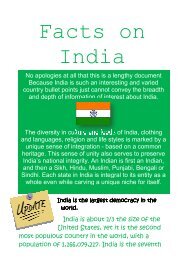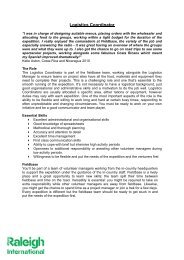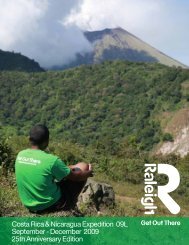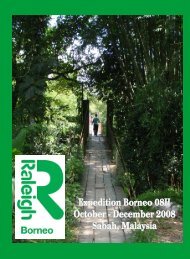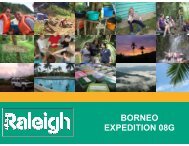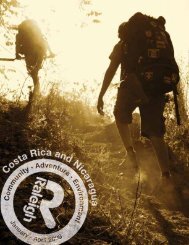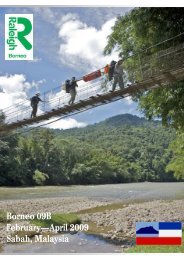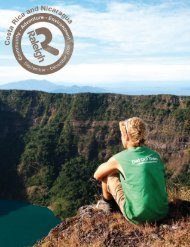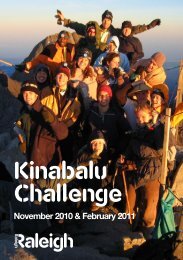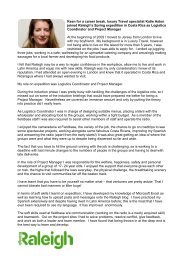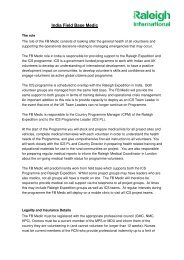Costa Rica & Nicaragua - Raleigh International
Costa Rica & Nicaragua - Raleigh International
Costa Rica & Nicaragua - Raleigh International
Create successful ePaper yourself
Turn your PDF publications into a flip-book with our unique Google optimized e-Paper software.
<strong>Costa</strong> <strong>Rica</strong> & <strong>Nicaragua</strong><br />
Volunteer Manager<br />
Expedition Kit Guide<br />
Contents<br />
1. Introduction (read this first!)<br />
2. ‘Summary of Kit’ lists<br />
3. Detailed kit information<br />
4. First Aid kit Information<br />
5. Packing Tips and other bits…
<strong>Costa</strong> <strong>Rica</strong>/<strong>Nicaragua</strong> Clothing and<br />
Equipment List<br />
1. Introduction (Read this first!)<br />
This list is designed to help you select and prepare your personal equipment for<br />
your <strong>Raleigh</strong> expedition. All specialist equipment (e.g. stoves, fuel, lifejackets,<br />
mountaineering equipment, ropes etc) and project equipment will be supplied by<br />
<strong>Raleigh</strong> <strong>International</strong>.<br />
Firstly, do not panic. We are not asking you to go out and spend lots of money on<br />
brand new items of expensive kit. Look at what you already have. There are some<br />
essential items of equipment, where it is worth getting high quality items that are<br />
designed to cope with the rigours of expedition life. You can make huge savings on<br />
other items by choosing cheap brands or buying second-hand.<br />
When you go into shops, remember that you are the customer, take your time, ask<br />
plenty of questions and try on as many different varieties of the item as you can. Try<br />
to recreate realistic conditions i.e. try on a rucksack with some weight in it, boots with<br />
walking socks and walk around and up and down steps.<br />
If you are starting from scratch and have never bought outdoor equipment before,<br />
please remember that there is no exact set of perfect kit for everyone and many<br />
decisions come down to personal choice and budget.<br />
If you already have some of the kit and are familiar with the items, please feel free to<br />
adapt the list according to what you already know works for you.<br />
Life on a <strong>Raleigh</strong> <strong>International</strong> expedition can be unpredictable and changeable, the<br />
climate can be very varied, amenities can be basic and you never know quite what is<br />
around the corner, but of course that it part of its appeal! So don’t forget that part of<br />
expedition life is about improvising, adapting and being resourceful with what you<br />
have.
How to use this Kit Guide<br />
On the following pages you will find a lot of information about various items of kit and<br />
clothing that you may need on expedition. We appreciate different people have<br />
different experiences of expedition style kit, if any at all, so we have tried to include<br />
as much information as we think useful but in a way that will be useful for everyone.<br />
Read the headings below to help work through it:<br />
1. Read the ‘Summary of Kit’<br />
2. Think about what kit you already have on the list<br />
3. Read the ‘Kit Information’ section to find out more about those<br />
items you are unfamiliar with, do not currently have or if you what<br />
to check your existing kit’s suitability<br />
4. Use the tick sheet on the ‘Summary of Kit’ to keep track of where<br />
you are<br />
5. Make sure you read the section on First Aid kits<br />
6. Finally, take a look at the ‘Packing Tips and Other Bits’ section as<br />
it may help you to make final decisions and to be best prepared<br />
before you go<br />
Top Tips to get you started!<br />
• If you are in the UK, attend your pre-expedition training events where you will receive<br />
lots more advice and information.<br />
• Obtain copies of outdoor equipment catalogues, which show and compare a wide variety<br />
of choices for each item on the list or look at the websites of major outdoor equipment<br />
stores.<br />
• Try items for size and fit in your local outlet and then buy the cheapest/best offer you can<br />
get (bear in mind the climate in which you will be living and working!)<br />
• Check for any discount that may be offered. Retail outlets will sometimes give a 10-15%<br />
discount for <strong>Raleigh</strong> <strong>International</strong> venturers.<br />
• Ask friends and family for advice if this is all new to you!<br />
• Remember…You will have limited opportunities to purchase additional items on<br />
expedition before travelling to your project sites and during changeover – try and bring<br />
everything you need with you.
2. ‘Summary of Kit’ Lists<br />
The Clothing and Equipment lists<br />
On the next pages you will find a summary of kit and clothing for your raleigh<br />
expedition.<br />
The clothing and equipment list has been divided into these sections:<br />
Essential:<br />
Recommended:<br />
You MUST take this item on expedition with you.<br />
This will make your life more comfortable or prove useful at<br />
times.<br />
IMPORTANT:<br />
We understand that you may be going out onto the expedition in a job role that<br />
you may think does not need all the equipment on this list. However due to the<br />
unpredictability and nature of expedition life it is entirely possible that you may be<br />
asked to either transfer projects with little notice or maybe spend time out of field<br />
base and on a project due to all sorts of reason. Therefore it is important for you<br />
to bring the entire kit list overleaf.<br />
If in doubt, please talk to the staff at your Development Weekend to clarify exactly<br />
what to bring.
Volunteer manager Kit List - <strong>Costa</strong> <strong>Rica</strong>/<strong>Nicaragua</strong><br />
Equipment<br />
Essential Bought it? Packed it?<br />
Rucksack (65-80 litre) (see detailed notes)<br />
Rucksack Liner<br />
Day sack<br />
Walking Boots<br />
Sleeping Bag (3 season)<br />
Sleeping Bag Liner<br />
Sleeping Mat<br />
Mosquito Net<br />
Water Bottles (2X1lt)<br />
Torch<br />
Mess tins<br />
Mug<br />
Cutlery<br />
Poncho<br />
Sunglasses<br />
Watch<br />
First Aid Kit<br />
Wash Kit<br />
Copies of documents<br />
Recommended<br />
Camera<br />
Karabiner<br />
String/cord<br />
Map Case<br />
Gaffer Tape<br />
Trekking Poles<br />
Sewing Kit<br />
Padlocks<br />
Penknife<br />
Bungee Cords<br />
Bought it?<br />
Packed it?
Volunteer manager Kit List - <strong>Costa</strong> <strong>Rica</strong>/<strong>Nicaragua</strong><br />
Clothing<br />
Essential Bought it? Packed it?<br />
Shirts (2 long sleeved)<br />
T-shirts (2)<br />
Fleece<br />
Trousers/Pants (2)<br />
Shorts (2)<br />
Socks (2 walking, 2 normal)<br />
Waterproof jacket<br />
Underwear (4-5 pairs)<br />
Swimming Costume<br />
Gloves (Outdoor Working)<br />
Hat (Wide brimmed Sun hat)<br />
Sandals<br />
Recommended<br />
Sweatshirt<br />
Trainers/Sneakers<br />
Sarong<br />
Bandanna<br />
Bought it?<br />
Packed it?
3. Detailed Kit Information<br />
Read Sections 1 & 2 before reading this information<br />
Equipment<br />
Remember to check your expedition Kit Summary in section 2 for details of essential and<br />
recommended equipment.<br />
Rucksack<br />
This is one of your most important pieces of equipment. It should be strong enough<br />
to survive the strain of expedition life so please ensure that it is designed for this.<br />
• If you already have a suitable rucksack that fits you well, is the right size and<br />
strong enough to last for three months, then do not buy a new one.<br />
• The capacity of the rucksack should be 65-75 litres for women and 70-80 litres for<br />
men. Your rucksack will be used to carry not only your own personal kit on<br />
project site but potentially team food and equipment.<br />
• If you are buying new, it is worth getting a rucksack from a reputable<br />
manufacturer. Ensure that the rucksack fits your back length well and that it has<br />
an internal frame and padded hip belt.<br />
• Look carefully at the back system. If it is adjustable, avoid buying one that looks<br />
complicated or dependent on breakable parts.<br />
• Removable side pockets are extremely useful and you may want to consider<br />
where you will strap on other items such as roll mats.<br />
• Ask qualified staff in the outdoor shop who will be able to advise you on the<br />
correct fit and size for your frame.<br />
Rucksacks are vulnerable to damage when being handled by airlines and it is a<br />
good idea to have a holdall or duffel bag big enough to put your packed<br />
rucksack in for the flight out to expedition. You can also use it as a<br />
“changeover bag” to keep spare kit in at field base when you are on a project<br />
site or trekking.
Sleeping Bag<br />
You will need a 3-season sleeping bag for <strong>Costa</strong> <strong>Rica</strong> & <strong>Nicaragua</strong>. Much of the time<br />
it will be hot at night so you may end up using your sleeping bag as an additional<br />
mattress! However, it does get cold at night in some projects and the adventure<br />
phase in the mountains due to the altitude so make sure your bag is warm enough. If<br />
you are someone who feels the cold then a 3-season bag may be necessary; if not<br />
then a 2-season bag may be all you need.<br />
In wet and humid conditions a down sleeping bag will quickly deteriorate and is<br />
difficult to dry out.<br />
• A compression stuff sack is useful for reducing the packed size of your bag<br />
(these cost about £7).<br />
Walking Boots If you already have a good pair of walking boots, bring them.<br />
• If you are buying new, get a fabric boot if possible as these tend to dry quicker<br />
(you are likely to be walking through streams where water will come in over the<br />
top of your boots). Leather is OK if that’s what you already have, but not highly<br />
recommended. It can be very wet and leather boots can be hard to dry out.<br />
Remember to wear them in before arriving in <strong>Costa</strong> <strong>Rica</strong> & <strong>Nicaragua</strong> –<br />
wearing them on the flight does not constitute breaking them in.<br />
• Remember to bring any boot care items (such as Nikwax) as recommended by<br />
your boot maker.<br />
• You will be living in your boots almost continuously (trekking, building etc) so<br />
make sure they are both a good fit and durable enough to last the expedition. It is<br />
difficult to buy boots suitable for a <strong>Raleigh</strong> <strong>International</strong> Expedition in <strong>Costa</strong> <strong>Rica</strong><br />
& <strong>Nicaragua</strong> – when you buy yours, look for signs of likely wear and tear such as<br />
strength of stitching, the durability of the sole and the strength of its attachment to<br />
the fabric/leather.<br />
• Look for boots that fit your foot shape, with a fairly stiff sole and good ankle<br />
support.<br />
• The very lightweight “light traveller” type of boot does not provide enough support<br />
for trekking over rough terrain.<br />
• Timberland / Caterpillar type work boots are also unsuitable for trekking.<br />
• US Army jungle boots are adequate if you have them but are very difficult to wear<br />
in.<br />
• If possible, bring a small repair kit that should include needles, strong thread,<br />
some glue and a roll of strong gaffer or duct tape. Spare bootlaces are<br />
essential.<br />
Sleeping Bag Liner<br />
This is to help keep your sleeping bag clean and may be all you need to sleep in on<br />
some project sites. It is much easier to wash than a sleeping bag. Try and get a liner<br />
as lightweight as possible, cotton is fine, silk is lighter and warmer, but more<br />
expensive.<br />
A cheap and easy idea is to fold a cotton sheet in half along its length and<br />
stitch the long sides together (or bring an old duvet cover).
Sleeping Mat<br />
You will use this virtually every day during the expedition. Full-length mats are better.<br />
In <strong>Costa</strong> <strong>Rica</strong> & <strong>Nicaragua</strong>, you will often be sleeping in hammocks. A mat is still<br />
essential as it provides extra insulation to keep you warm.<br />
• A closed-cell foam mat such as a Karrimat is ideal.<br />
• A lightweight self-inflating mattress such as a Thermarest which comes in a<br />
variety of sizes. They are more comfortable but also more expensive. (Make<br />
sure you bring a Thermarest repair kit as they are easily punctured).<br />
Mosquito Net<br />
There is a definite risk of malaria and dengue fever in <strong>Costa</strong> <strong>Rica</strong> & <strong>Nicaragua</strong> so a<br />
mosquito net is essential.<br />
• You will need a box-shaped net so that it can be attached by all 4 corners and fit<br />
under flysheets for jungle hammocks or camp beds.<br />
• The net must have been dipped in Permethrin that prevents mosquitoes biting<br />
through the net. Most nets on the market have been pre-dipped but check before<br />
you buy.<br />
• Tie long pieces of string/cord onto each corner before you go so you don’t have<br />
to mess around with it on your first night in the jungle.<br />
Liners<br />
It is important that you keep your kit dry and waterproof while inside your rucksack.<br />
There are two types of suitable rucksack liners to choose from:<br />
Canoebags/Drybags<br />
• These are extremely sturdy waterproof bags where the top folds over and clips<br />
together to provide a very effective waterproof seal.<br />
• They come in a variety of sizes and allow you to keep your sleeping bag in one<br />
and spare clothes in the other. Whilst some of your clothing may get wet it is<br />
important that your sleeping bag/liner and a spare change of clothes is kept dry at<br />
all times.<br />
• Small drybags are very useful for keeping cameras, letters, notebooks and<br />
valuables in.<br />
Rucksack Liners<br />
• These are tough waterproof liners but they do not have the rollover fastening or<br />
welded seams of the dry bags.<br />
• Whatever you use should be 100% waterproof and durable.<br />
Fertiliser bags are a good cheap option but plastic bin liners are not tough or<br />
waterproof enough.
Stuff sacks<br />
• These are great for organising your stuff, so you’re not rooting around endlessly<br />
in your rucksack for 10 weeks. Useful for the trekking phase when you will have<br />
to pack up quickly each morning. Get different colours to make it easier to<br />
organise your clothes etc.<br />
Day Sack<br />
A small rucksack of about 30-litre capacity is useful for carrying personal kit on day<br />
outings from your project site and also makes a good piece of hand baggage on<br />
flights. There is no need to buy an expensive model from one of the good rucksack<br />
manufacturers, a cheaper model will do.<br />
Water Bottles<br />
The absolute minimum you need to bring is TWO 1-litre water bottles. Try to bring a<br />
combination of collapsible and rigid containers with a capacity in whole litres rather<br />
than halves because water-purifying tablets purify in 1-litre volumes.<br />
• Cycling-style water bottles are ideal as they have a wide neck and are<br />
inexpensive. Other popular models are Sigg and Nalgene..<br />
• Ortlieb or Platypus collapsible water bags are useful because they take up less<br />
volume when empty. You can also get a tube adapter so that you can drink<br />
without having to remove the bottle from your pack, which is very beneficial when<br />
trekking.<br />
You must have enough one-litre puritabs to last your entire trekking phase (approximately 180 litres, or<br />
180 tablets). If you are planning to travel on after expedition you should bring more. It is vital that you<br />
have enough before you leave for expedition - please do not assume you will be able to buy puritabs in<br />
<strong>Costa</strong> <strong>Rica</strong> & <strong>Nicaragua</strong>. For adventure and community phases it is useful to have some puritabs but<br />
generally the water is purified centrally.<br />
Torch/Flashlight<br />
This is a vital piece of equipment as there is rarely any electricity at project sites.<br />
• A head torch is very highly recommended as it allows you to operate ‘hands<br />
free’.<br />
• Petzl are the best-known manufacturer, but there are others, just make sure you<br />
get a good quality one.<br />
• A head torch which runs on AA (LR6) batteries is most useful, as these ‘walkman’<br />
batteries are easiest to get hold of. If you have a head torch which takes 4.5V<br />
flatpack batteries, make sure you take an AA adaptor as 4.5V batteries can be<br />
hard to get hold of in <strong>Costa</strong> <strong>Rica</strong> & <strong>Nicaragua</strong>.<br />
• Head torches with LED bulbs are a good idea, as they use up batteries less<br />
quickly than other types such as halogen bulbs.<br />
• Bring plenty of batteries and a cheap spare torch.<br />
• Maglites are a cheaper alternative with a head strap.
Penknife<br />
Make sure this has a tin opener, scissors and one good blade (should be less than<br />
3 inches). Penknives get lost very easily so it might be worth attaching it to a piece<br />
of cord so you can wear it around your neck. There is no need to go to the expense<br />
of getting a Leatherman-type tool.<br />
Mess Tins<br />
Mess tins are metal containers, usually square, that fit into each other. You will need<br />
a set of two for cooking and for use as bowls/plates. Mess tins bought from Army<br />
Surplus stores are usually stronger than ones sold in outdoor shops.<br />
Mug<br />
Plastic, enamel or tin are all fine.<br />
Cutlery<br />
A spoon is the most essential item. Bring spares, as you are very likely to loose<br />
them. A set with holes in the handles can be attached to your mess tin with a piece of<br />
cord for safekeeping.<br />
Sunglasses<br />
These are a very important piece of equipment. Check that they provide an effective<br />
filter against UV radiation, bring a hard case to keep them in and a neck leash such<br />
as a croakie to stop them from falling off or being lost.<br />
Watch<br />
This needs to be water resistant, ideally with an alarm facility. Do not bring an<br />
expensive one (a basic Casio watch which can be bought for about £12 is ideal).<br />
Bungee Cords<br />
These can be used for strapping extra items onto your rucksack or for making<br />
shelters. About 6 bungees from 50-100cm long in bright colours (i.e. not jungle<br />
green) should be fine. Do NOT bring thick bungees (e.g. the ones you might use on<br />
the back of your bike) because these are usually too strong and can rip or tear<br />
materials they are attached to. Better to bring thin green than thick bright!<br />
String/Cord<br />
This has a multitude of uses such as washing lines, hanging mosquito nets, etc. Guy<br />
rope is stronger and not as expensive as “paracord” (strong string). The<br />
best/cheapest place to get some is somewhere like Woolworths or any garden<br />
centre/hardware store. Bring at least 50 metres if possible.<br />
Photocopies of all your essential documents<br />
You should always have a spare record of your essential travel documents. These<br />
will make your life a lot easier if they get lost or stolen. These should be kept<br />
waterproof in a bag.<br />
1. Passport (copy the page with your passport number, the date and place of issue<br />
plus pages that contain any relevant visas).<br />
2. Vaccinations (a copy of all of the dates of your vaccinations).<br />
3. A record of the serial numbers of your travellers cheques.
4. An emergency telephone number to call to replace stolen/lost traveller’s<br />
cheques/credit cards.<br />
5. Insurance documents (other than <strong>Raleigh</strong>), including your policy number and 24<br />
hr emergency tel. no.<br />
Camera<br />
An inexpensive 35mm compact camera is ideal for taking photos of expedition life.<br />
• Take enough spare camera batteries with you, as these are expensive and<br />
difficult to buy on expedition. Standard film is available in <strong>Costa</strong> <strong>Rica</strong> & <strong>Nicaragua</strong><br />
although APS may be difficult to find.<br />
• Make sure you have a protective case – something waterproof such as a small<br />
tupperware box works well. If your camera is not kept fully waterproof, it will be<br />
ruined as the humidity can play havoc with the electrics in cameras. Packets of<br />
silica gel are useful to absorb moisture.<br />
• Film rated 100 ASA should be suitable for most shots, but a 400 ASA would be<br />
useful for under the forest canopy and/or poor weather conditions (or a good<br />
flash).<br />
• For the more serious photographers, if you wish to bring a larger, more expensive<br />
model, that’s fine but please remember that personal belongings are not covered<br />
under <strong>Raleigh</strong> insurance. Remember lens-cleaning fluid/cloths.<br />
• If you bring a digital camera, make sure you bring enough memory cards and<br />
batteries to last the whole expedition, you are unlikely to be able to charge it if it<br />
is rechargeable.<br />
Kodak, Fuji and Boots produce inexpensive waterproof disposable cameras for<br />
about £10, which take quite good photos and are relatively indestructible.<br />
Karabiner<br />
Karabiners are metal safety clips often used for rock climbing. One or two snap link<br />
karabiners are useful for a variety of uses such as clipping a water bottle or camera<br />
case to a rucksack, or for securing luggage to vehicle roof racks. There is no need to<br />
buy expensive climbing karabiners.<br />
Map Case<br />
An A3 waterproof map case is useful to keep journals and other important documents<br />
protected.<br />
Gaffer Tape<br />
Gaffer (or duct) tape is really useful for repairs and making shelters. A big roll from a<br />
hardware store is cheaper than a little roll from an outdoor store.<br />
Poncho<br />
Ponchos are good for sheltering from the heavy rain or to make simple shelters.<br />
Ponchos vary in weight and durability depending on the model; they are available<br />
from the army surplus stores. Some ponchos are second hand, so check their<br />
condition. Remember, you will have to carry this and we will be providing you with a<br />
personal tarpaulin.<br />
If you are trekking then a Poncho is essential!
Trekking Poles<br />
These are not essential and are really a matter of personal preference. Poles are<br />
ideal for trekking to reduce pressure on knees and joints and prevent injuries,<br />
especially going downhill. Also can be useful for building shelters.<br />
Sewing Kit<br />
Your kit will be stretched to its limit so a sewing kit is very useful for repairs.<br />
Small Padlocks<br />
Useful to padlock rucksack zips whilst in transit or storage during the expedition.<br />
Other Optional Items<br />
• Playing cards<br />
• Journal<br />
• Games<br />
• Books<br />
• sketch pad<br />
• phrase book<br />
• personal stereo<br />
• laminated photos of home to show to communities<br />
• postcards<br />
• herbs and spices in camera film cases
Clothing<br />
Remember to check your expedition Kit Summary in section 2 for details of essential<br />
and recommended equipment.<br />
Remember, everything you wear on a daily basis will be dirty and trashed by the end<br />
of expedition.<br />
• Do not bring any clothes with any form of camouflage pattern.<br />
• White or light coloured clothing will get dirty.<br />
• Plenty of re-sealable plastic bags or stuff sacks with drawstrings are good for<br />
separating kit and keeping it dry.<br />
• You may want to bring one set of slightly nicer clothes to wear at changeover and<br />
for travelling home.<br />
• Avoid skimpy clothing like vest/tank tops and short shorts. There are no definite<br />
rules as to what is appropriate, and you will rarely be told if you have offended<br />
anyone. Consider where you are (rural areas are more conservative), what the<br />
community is wearing, how you want to be viewed and what impression you want<br />
to create of your (i.e. the foreign) community.<br />
• Keep clothing to the minimum.<br />
Stock up on old shirts from charity shops so you can throw them away at the<br />
end of expedition.<br />
Shirts<br />
Two durable, lightweight, long-sleeved shirts. These are essential for protection<br />
against mosquitoes especially at dusk.<br />
T-Shirts<br />
At least three T-shirts. You will be receiving a free <strong>Raleigh</strong> <strong>International</strong> T-shirt,<br />
sleeping in it will keep it concrete-free! Vest tops are a nice option to have but may<br />
be inappropriate in some community situations.<br />
Fleece<br />
If you are doing the adventure phase then a lightweight fleece jacket/jumper is<br />
particularly useful if you feel the cold, especially when you are trekking at high<br />
altitudes.<br />
Shorts<br />
Take two pairs of cotton shorts (not running shorts) that are made from fairly heavyduty<br />
cotton. They can be lightweight (fast drying will be useful) but should be<br />
respectable, not too short or tight.
Trousers/Pants<br />
At least two pairs. One reasonably smart pair (i.e. clean and not ripped) for wearing<br />
in town, another that you don’t mind getting completely trashed on project sites.<br />
• They should be light/medium weight cotton or polycotton, quick drying, loose<br />
fitting and durable e.g. combat-style trousers.<br />
• Zip off trousers are popular for their versatility<br />
• Specialist trousers (e.g. Rohan) are quite expensive although they are durable<br />
and do dry very quickly.<br />
• Please do not bring denim jeans to wear on your project site. They are too hot<br />
and take too long to dry. However it if you like to wear jeans then they are good<br />
to have for travelling on or for changeover times.<br />
Socks<br />
You need to take at least four pairs of socks: two pairs of thick walking socks and two<br />
pairs of normal cotton socks.<br />
Waterproof Jacket<br />
A light waterproof jacket is all that is required. Think very carefully about bringing an<br />
expensive jacket as it may get damaged on a project site.<br />
Underwear<br />
Cotton underwear is more hygienic than synthetic. About four/five pairs should be<br />
enough to last the expedition. Dark colours are recommended, as they don’t show<br />
the dirt. Sports bras are very useful.<br />
Swimming Costume<br />
For men, please take a pair of respectable swimming shorts. For women, please<br />
bring a one-piece swimming costume. Women may wish to bring a bikini as well, as<br />
there may be times when it is acceptable to wear one.<br />
Sarong<br />
This has a multitude of uses and can be bought from a variety of stores for about £8.<br />
(Alternatively, just use a length of material.) A sarong can be used as a towel,<br />
blanket, clothing and is quick drying and lightweight. This applies to men, too!<br />
Gloves<br />
Hard-wearing, also suitable for working with tools on project sites.<br />
Hat<br />
Preferably wide brimmed to keep the sun (and the rain) off.
Sandals<br />
A pair of open sandals with toe and ankle straps, often called ‘rafting sandals’ are<br />
essential. Teva, Merrell and Reef sandals have all had good reports. Flip-flops are<br />
not recommended. It is important, for safety reasons that you always have something<br />
on your feet – unless you are in bed!<br />
Trainers/Sneakers<br />
One pair to wear round camp and if you have a problem with your boots.<br />
Sweatshirt<br />
Heavier and slower to dry than a fleece, but can still be handy.<br />
Bandana<br />
This also has a multitude of uses; for shading the neck from the sun, as a flannel, as<br />
a seat cover in vehicles with plastic seats, emergency triangular bandage.<br />
Waterproof Over-Trousers<br />
Only really recommended for the adventure phase. A great piece of kit that will keep<br />
you dry and happy when it is pouring down.
Toiletries and Wash Stuff<br />
You may want to bring enough toiletries to last for the whole expedition, but you can<br />
restock at the fieldbase shop. The following is a list of a few essential things but don’t<br />
forget all the usual - toothpaste, deodorant, shampoo etc.<br />
• Suncream, aftersun and lip block – make sure you take strong sun protection<br />
factor. One tube of strength SPF 45 and two tubes of SPF 30 is ideal. Please buy<br />
water-resistant suncream and don’t forget lip block or aftersun lotion.<br />
• Insect repellent – buy insect repellent with a high percentage of DEET (50% or<br />
over) e.g. Jungle Formula or Lifesystems. Make sure you get enough for the<br />
whole expedition – 3 50ml bottles should be enough. Try out the repellent before<br />
you go to check for skin reactions.<br />
• Wetwipes – brilliant for washing when water isn’t in abundance or when you’re<br />
on long, hot journeys. Try to buy fragrance free wipes.<br />
Glasses/Contact Lenses<br />
If you need them, bring your spectacles, as well as a spare pair. Bring hard cases to<br />
keep them in. Wearing contact lenses is not recommended due to the increased risk<br />
of infection associated with using contact lenses in a dirtier environment. This applies<br />
to all types of disposable and non-disposable lenses<br />
Chlorine Based Water Purification Tablets<br />
If your are attending a community or enviromental phase then please bring some<br />
water purification tablets with you as you may need these at times. Chlorine based<br />
are best and you should try and bring enough to purify 100 litres of water.<br />
Top Tips<br />
• Try to bring as many environmentally friendly, plant based or biodegradable<br />
toiletries as possible in order to reduce the impact you have on the local<br />
environment.<br />
• A small nailbrush is good for washing dirty clothes.<br />
• If you only need small quantities of something then small plastic bottles from<br />
pharmacies like Boots, Superdrug or other shops (e.g. Muji) are really useful.<br />
• Instead of a towel, you might prefer a sarong, which can be used for lots of<br />
other things. It’s a good idea to have a loop on the corner so it can be hung in<br />
the sun to dry.<br />
• Try to bring tampons with applicators, they are generally more hygienic.<br />
Should be kept in a ziplock bag or waterproof container. Please try not to take<br />
tampons with plastic applicators.<br />
• Try to buy creams, lotions, deodorants etc that don’t have a strong fragrance<br />
because this attracts mosquitoes.
4. First Aid Kits<br />
<strong>Raleigh</strong> <strong>International</strong> recommends that you buy a ready made first aid kit. There are<br />
a number of places that sell them including:<br />
• Local hospitals or medical centres<br />
• Pharmacies/drugstores, supermarkets, travel stores etc.<br />
If you are living in or visiting the UK you could try:<br />
• Nomad Travel Store & Travel Clinics<br />
Website: www.nomadtravel.co.uk E-mail: sales@nomadtravel.co.uk or Tel: 020<br />
8889 7014.<br />
Nomad specialises in travel medicine and equipping expeditions. The <strong>Raleigh</strong><br />
Venturer Medical Kit has all the items listed below (except Puritabs) and can be<br />
delivered to any address in the UK. The kit can be tailored to your specific<br />
requirements and extra items can be added. Nomad run a mail order service and<br />
catalogue request line on 020 8889 7014.<br />
• Trailfinders 194 Kensington High St, London W8. Tel: 020 7938 3999<br />
• Interhealth 157 Waterloo Road, London SE1. Tel: 020 7902 9000<br />
• Travelclinic at Hospital for Tropical Diseases Tel: 020 7388 9600<br />
If you are not buying a ready-made kit then you must have the following essential<br />
items in your first aid kit. All items should be kept in a waterproof container such as a<br />
small sandwich box.<br />
Each project site will have a supply of sterile needles and syringes. If you are<br />
planning to travel on after the expedition then we recommend that you buy a sterile<br />
kit. These can be bought from the suppliers above at a cost of approximately £10.<br />
What do I need in a First Aid Kit?<br />
Oral re-hydration sachets e.g. Dioralyte<br />
Antihistamine cream<br />
Gauze<br />
Painkillers e.g. Paracetamol or Nurofen<br />
Plasters<br />
Tweezers<br />
Antiseptic cream e.g. Savlon<br />
Zinc oxide tape<br />
Athletes foot powder e.g. Mycil<br />
Vaseline<br />
Small non sticky dressings e.g. Melonin<br />
Safety pins 5<br />
Small pair of scissors 1<br />
Crepe bandage 1<br />
Digital Thermometer (not mercury) 1<br />
Recommended Quantity<br />
10 minimum<br />
1 Tube<br />
1 Packet (5 Pieces)<br />
1 Packet<br />
1 Packet<br />
1 Pair<br />
1 Tube<br />
3 Rolls<br />
1-2 Pot(s)<br />
1 Pot<br />
Puritabs (for 1 litre water bottles) 180-200<br />
Small bottle of Iodine – essential for cuts<br />
Multivitamins<br />
4 Single Dressings<br />
1 Small Bottle (50ml)<br />
1 Pot
5. Packing Tips and Other Bits..<br />
Where to buy your kit<br />
• You can but kit through Nomad Travel at www.nomadtravel.co.uk at 10% off,<br />
with a further 5% going to <strong>Raleigh</strong>’s charitable activities direct from Nomad.<br />
First Aid kits bought through Nomad are designed and made specifically for<br />
<strong>Raleigh</strong> expeditions.<br />
• Most high street outdoor kit retailers will give you 10-15% off if you can show<br />
them that you are part of a <strong>Raleigh</strong> Expedition<br />
• Check with family and friends,, you never know what kit people have hidden<br />
away in the loft or under the bed they aren’t using any more!<br />
Packing and Practicalities<br />
• You should always know where everything is in your luggage. Ensure that items<br />
you may need quickly e.g. passports and medical packs are easily accessible.<br />
• Carry all your valuables and 24 hours worth of kit (such as toiletries, daily<br />
medication, underwear etc) in your hand luggage in case your main luggage is<br />
delayed.<br />
• All battery operated/electrical goods (including spare batteries), alarm clocks,<br />
torches, and aerosols (including contact lens aerosols) must be packed in your<br />
hand luggage.<br />
• Pack any sharp objects e.g. penknife, scissors and knives in your main baggage,<br />
otherwise airport security might confiscate them.<br />
• Make sure you can quickly identify your rucksack as yours, by clearly labelling it<br />
or tying something bright onto one of the straps. A robust luggage tag is ideal.
Valuables<br />
Remember that your personal belongings are NOT covered by <strong>Raleigh</strong> insurance,<br />
even if stored on <strong>Raleigh</strong> premises. We highly recommend that you take out your<br />
own personal belongings insurance (you can do this direct with <strong>Raleigh</strong>’s Insurance<br />
company).<br />
• Space in the field-base safe is limited. Cash, travellers’ cheques and<br />
important/valuable documentation only can be stored there. There is no room for<br />
bulky objects such as camera lenses, mobile phones etc.<br />
Mobile Phones<br />
Mobile phones and GPS receivers are discouraged as they are unnecessary on<br />
expedition and safe storage for these cannot be provided at field-base.<br />
Mobile phones do not work in <strong>Costa</strong> <strong>Rica</strong>/<strong>Nicaragua</strong> as there is no roaming, so<br />
unless you are travelling on afterwards to a different country then do not bring one.<br />
Money<br />
• <strong>Raleigh</strong> <strong>International</strong> will be providing your food, transport and expedition<br />
expenses. You will need to bring some spending money for souvenirs, postcards,<br />
stamps, toiletries etc.<br />
• We recommend that you bring $450 to $600; this should be a combination of<br />
travellers’ cheques and cash. Do Not bring British pounds.<br />
• Travellers’ cheques can be changed into cash during the changeover period.<br />
Where to buy your kit<br />
Don’t forget to try and borrow kit from friends and family, but there is bound to be<br />
some kit you need to buy.<br />
Places to buy kit:<br />
o Nomad Travel Stores - www.nomadtravel.co.uk<br />
You will automatically get 10% discount as a <strong>Raleigh</strong> participant, plus nomad<br />
will give <strong>Raleigh</strong> an extra 5% back to its charitable work<br />
o Ask in your local high street store for discount, mentioning <strong>Raleigh</strong> as many<br />
will give you between 10-15% off if you do<br />
o Other useful web sites are:<br />
www.oswaldbailey.co.uk/<br />
www.yeomansoutdoors.co.uk<br />
www.regatta.com/


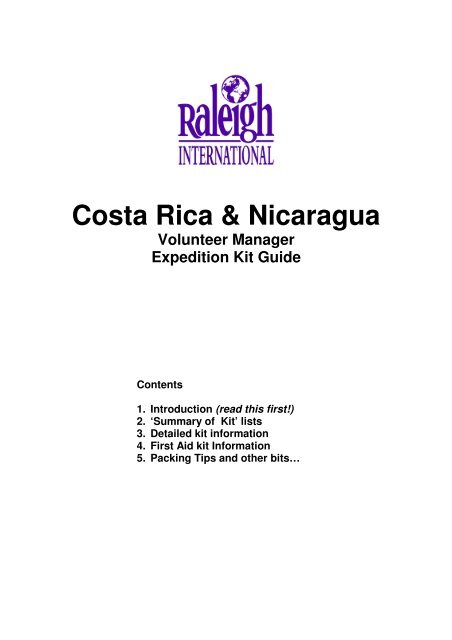
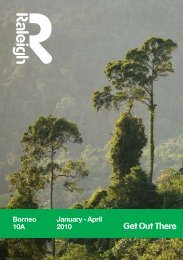
![Love Off-the-beaten-track With Raleigh International[1]](https://img.yumpu.com/25658839/1/184x260/love-off-the-beaten-track-with-raleigh-international1.jpg?quality=85)
